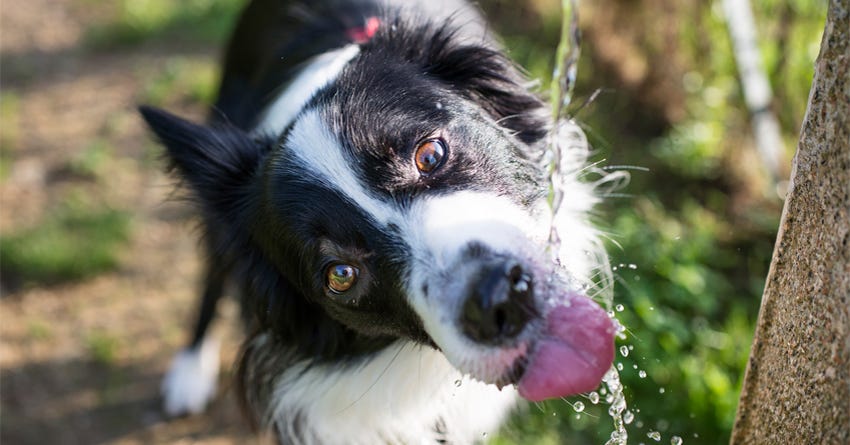Hydration is one of the most important aspects of pet ownership that if not maintained can cause life-threatening health concerns.
Water makes up 70-80% of a dog or cat’s body mass, so it’s a key nutrient in maintaining normal cellular function. A loss of only 10% of bodily fluids can lead to a variety of clinical signs of illness that necessitate an examination and treatment with a veterinarian. Promoting hydration and combating dehydration is an ongoing process for pet owners. This article aims to put a practical spin on how owners can best maintain their canine or feline companion’s hydration so preventative illness can be avoided.
How Does Canine & Feline Dehydration Occur?
Lack of liquid consumption and loss of body fluids reduces the overall volume of a pet’s blood and leads to dehydration. All body parts suffer when there’s not enough fluid to permit proper movement of blood through the arteries and veins, and lymph in the lymphatic vessels. Thick blood and lymphatic fluid inefficiently peruse and drain organs, muscles, and other tissues which results in poor oxygenation and nutrient delivery, reduced toxin removal, and deficient white blood cell activity in all body systems. Large bowel diarrhea (AKA colitis) and insensible water loss (evaporation through the lungs, nose, paw pads, etc.) are two significant ways that fluid loss leads to dehydration. A variety of conditions including cancer, infection, immune system disorders, glandular problems (kidney and liver disease, pancreatitis, etc.), toxicity, and others can cause nausea, vomiting, and decreased fluid and food consumption. When your pet doesn’t consume enough moisture by drinking water or eating moist meals, then dehydration and a variety of health conditions can occur.
Clinical Signs of Canine & Feline Dehydration
Dehydration is a diagnosis often seen in conjunction with other ailments, so it’s crucial for owners to be aware of potential for dehydration in the face of any illness. Clinical signs of pet dehydration include (but aren’t exclusive to):
- Lethargic behavior - Pets act less energetic or more fatigued and show exercise intolerance when less water is present in the body.
- Decreased appetite - Dehydration reduces blood flow to the digestive tract, so less involuntary muscular contraction occurs in the stomach and intestines and causes slowing down of the digestive tract and decreased appetite.
- Reduced urine and bowel movement volume and frequency - Reduced water consumption or increased water loss lessens the volume and frequency of urine and feces, as moisture is preserved in the vital organs (heart, lungs, and brain) in attempt to permit their essential functions in maintaining the basic functions of life.
- Water seeking behavior - Dehydration will cause your pet to seek water, which could have him striving to drink from both familiar and unfamiliar places. A familiar and good place would be his water bowl. Unfamiliar and potentially harmful places include the toilet bowl, plant dishes, puddles on the ground, slow-moving streams, lakes, oceans, etc. as all sites can harbor toxins, infectious organisms (bacteria, parasites, molds, etc.), or other dangerous substances.
- Delayed capillary refill time and tacky mucous membranes - A well-hydrated pet’s oral mucous membranes (gums) should appear vibrant pink and moist. When dehydrated, the gums become tacky (sticky). Additionally, when the mucus membranes are firmly pressed to push out blood, the capillary refill time (CRT, or time it takes for blood to refill tissue) is delayed. Normal CRT is one to two seconds while delayed CRT is two seconds or longer.
- Decreased skin turgor - A pet’s skin should be pliable and soft, but when enough water is lost, skin becomes firmer. This phenomenon is called decreased skin turgor, which manifests as a lack of ability for skin to retain its normal shape. If you were to gently lift up the skin between your pet’s shoulder blades (“scruff” or nape of the neck), a ridge of flesh would remain instead of quickly flattening out in a few seconds.
- Elevated heart rate and respiratory rate - The blood thickens and inefficiently flows around the body during dehydration causing the heart to contract faster in an effort to deliver nutrients and oxygen as well as remove metabolic waste from body tissues. Respiratory rate also increases in an attempt to bring more oxygen into the body. Normal heart rate is 70-160 beats per minute for most dogs (smaller dogs have faster heart rates) and 160-240 beats per minute for cats. A dog’s normal respiratory rate is 10-30 breaths per minute (smaller dogs typically breathe faster) and cats generally have 20-30 breaths per minute.
- Reduced body temperature - Deficient body water causes reduced blood flow to the colon/rectum and ears, which are the two most common orifices used to determine a dog or cat’s temperature. Normal canine and feline body temperature is 100-102.5 F. Body temperature below 100 F (hypothermia) can occur with dehydration. Conversely, elevated body temperature above 102.5 F (hyperthermia) can cause increased insensible body water loss and lead to dehydration.
Preventing Canine & Feline Dehydration
Owners should be aware of their pet’s daily hydration needs. A healthy, adult dog requires one ounce of water per pound of body weight every 24 hours. Healthy, adult cats should consume about the same quantity of water (in milliliters= mL) as the number of calories required per day (refer to this Calorie Requirements for Cats chart). My top tips include:
- Provide clean, fresh, room-temperature water having the same level of purity that you drink. Never provide water for your pet that you wouldn’t consume yourself like that which is from the hose, a few days old, dirty, and other less-than-safe sources. I recommend room temperature because cold and ice water can cause reduced blood flow and muscular contraction in the stomach and small intestines, which slows down digestive tract function.
- Prevent your pet’s water sources from potentially having microorganisms or toxins capable of causing mild to severe illness. Puddles, still bodies of water (ponds, etc.), communal water bowls (dog park, daycare, etc.), plant dishes, Christmas tree containers, and other unclean sources should be avoided.
- Use commercially-available circulating water dispensers to promote a pet’s curiosity and interest in drinking, especially for cats or finicky pooches.
- Feed your pet a moist diet. Human-grade diets like home-prepared or commercially available rehydrated options like The Honest Kitchen should be chosen over canned options having moistening agents (carrageenan, guar or xanthan gum, propylene glycol, etc.). Most canned foods are closer to the format in which nature intends food to be consumed as compared to dry foods (kibble), so feeding canned over kibble is my suggestion if home-prepared or rehydrated commercial options aren’t available.
- Minimize your pet’s time spent exposed to extreme heat and sun. Frequently seeking shade and cool will reduce insensible body water loss.
- Coerce your cat to drink more via broth, tuna-water cubes, or other tasty liquids. Cats are notoriously challenging to make eat and drink in times of illness or injury. Adding low-sodium broth (chicken, beef, etc.) to foods, offering treats of frozen tuna water (can of tuna pureed with water in a blender then frozen and served as individual cubes), and serving a goat-milk probiotic beverage like The Honest Kitchen's Instant Goat's Milk can motivate your feline friend to consume more liquids.
Recommended Reading: Cat's and Goat Milk: Everything You Need to Know Hopefully, by taking measures to promote hydration and deter dehydration, your pet’s normal body functions will remain stable and illness won’t emerge. What steps do you take to keep your pet well hydrated? Feel free to share your experiences in the comments section.


